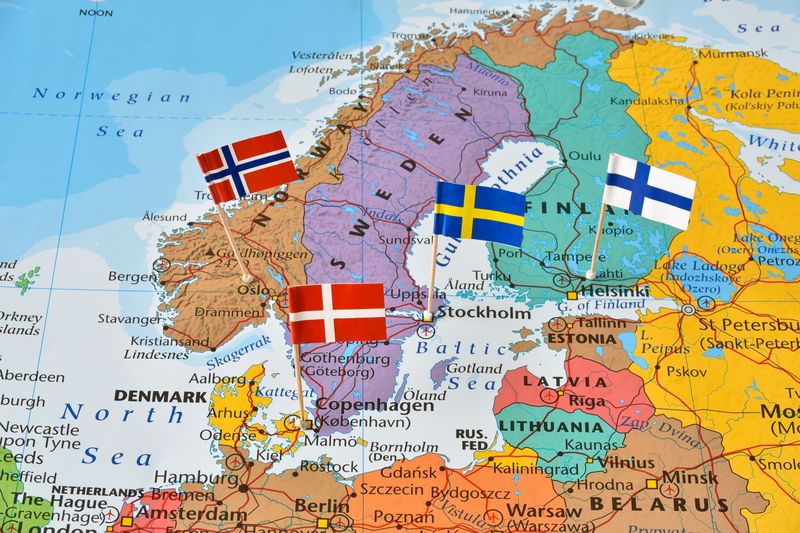Public sector borrowers in the Nordic region have been at the forefront of the ESG bond market since its very early days. It would appear to be a leading position they have no intention of relinquishing any time soon.
Green bonds have found a ready home in the Nordics, with the region playing a leading role in the market’s development. Local government financing agencies were early adopters of the instrument as a way of mobilising private finance into reaching a sustainable, climate resilient future. The agencies continue to contribute to the search for transparency, standardisation and reporting.
Nordic participation in green bonds was established right from first stirrings. It was in response to specific Scandinavian investor demand for climate-change mitigating investment opportunities that, in 2008, Nordic financial group Skandinaviska Enskilda Banken teamed up with the World Bank to bring the multinational development bank’s first green bond – a SKr2.3bn (US$370m) six-year deal. A deal on which Norway’s climate research institute Cicero provided the second-party opinion.
Since then, borrowers in the region have claimed numerous green breakthroughs. In 2010, the Nordic Investment Bank made an early foray into the market while in 2013 Kommunalbanken became one of the first European SSA issuers to go green in US dollars, Vasakronen launched the first corporate green bond, and the City of Gothenburg emerged as the world’s first city to tap the green investor base.
Green bonds denominated in Swedish kronor now represent around 15%–20% of annual issuance, a number that bears testament to the rapid assimilation of green finance in the Nordics.
All for one, one for all
In a region famed for its progressive social outlook, green finance lends itself perfectly to the economic strategy of addressing carbon emissions and building resilience. And there are few institutions better placed to take advantage of the instrument than the dominant lenders to regional and local government in Denmark, Finland, Norway and Sweden: KommuneKredit, Municipality Finance, KBN, and Kommuninvest.
These Nordic financing institutions play a key role in funding the essential services provided by their clients: governments at regional, county, municipal and city level. And it is locally that administrative offices are responsible for investing in the range of assets that benefit the wider public, such as environmental projects, infrastructure, energy, healthcare, social housing, transport and education.
Financing at an aggregate level, through the agencies, provides a cost-effective financing route for group members that would not be able to reach the same funding targets in the open market.
“Members of the KommuneKredit association, Danish municipalities and regional authorities, are jointly and severally liable for all our obligations,” said Guri Weihe, head of sustainable finance, KommuneKredit. “This set-up allows us to borrow funds at a low interest rate. Because we do not have to make a profit on our lending and leasing operations or pay dividends to our owners, and as our administrative expenses are quite low, our members are secured a low interest rate on their loans.”
The strength of the arrangement is acknowledged by the ratings agencies. According to Moody’s, credit exposure is limited due to low-risk lending activities, close supervision at the central government level and explicit guarantees from the bodies to which they lend.
“It’s a beautiful concept,” said Mats Olausson, senior advisor, climate & sustainable finance, SEB. “Local government debt offices with joint objectives, teaming up on a voluntary basis and getting stronger together. It’s an organisational alignment that gives greater access to the deeper pockets found in the capital markets, and this results in cheaper funding at the local level.”
The result is that the agencies are all well-known, top-rated, frequent visitors to the capital markets. In the last few years, they have also become regular issuers of green bonds.
Issuance from the four agency borrowers has represented between 10% and 20% of total Nordic bond supply in the three years since 2018, according to Refinitiv. The volume of green bonds delivered to the market by the big four amounted to a US$2.2bn equivalent in 2020, some 9.7% of all the green deals issued from the region in that year.
Green progress
Green bond issuance in the region and globally has been on an impressive rise over the last decade, with arguably the tipping point in the market’s momentum coming with the inception of ICMA’s Green Bond Principles in 2014. The GBP set guidelines on transparency, on the use and management of proceeds, the project selection and the evaluation process against which borrowers and investors are able to agree that the project outlined for investment contributes to the war on climate change. A Scandinavian presence was even evident in the formation of the GBP, with SEB a member of the initial executive committee.
The transparency and discipline engendered in the bond market following the launch of the GBP feeds through into the agencies’ lending activities.
“Governance of our green lending is in line with the GBP,” said Antti Kontio, head of funding and sustainability, MuniFin. “It determines how the projects are selected and how impact is reported.”
Only when a sufficient portfolio of green lending is assembled do the agencies tap the capital markets, and green lending has been building at a rate that has allowed the borrowers to establish benchmark deals, in most cases, on a yearly basis. But, as climate-related targets become more rigorous at the state level and the consequent demands placed on local governments increases, so green lending, and green bond issuance, is likely to increase – provided the developing regulatory environment continues to facilitate their growth.
Lending is sharing
The use-of-proceeds aspect to green financing has resulted in a significant change in relationships in the financial markets. From bond investor through to issuer, lender to client, the discussion has broadened from being purely financial. The same is evident within institutions, where teams have been brought together to work across disparate departments. It has contributed to a widespread sense of cooperation and collaboration towards a common cause.
“Most of the municipalities have climate targets and strategies, but some of the smaller ones don’t have the resources to manage them efficiently,” said Kontio. “Our discussions are very detailed, and we are here to help educate and support our customers in their efforts to reach their goals, not just talk about finance.”
MuniFin also has the option of providing a market discount of up to 10bp on its green lending in order to encourage its clients to build sustainably. The margin is determined by the extent of the impact from the project.
An up-to 10bp price-discounting mandate also sits within the 100% government-owned KBN.
“We’ve completed US$2.9bn in lending to green projects,” said Torunn Brana, head of green finance, KBN. “That represents 8%– 9% of the total lending portfolio. It is still a minority of our business but it is growing fast. In 2019, almost half of lending growth was in the form of green loans.”
The shift towards green lending in Norway is reflected around the region. For Kommuninvest, green loans represented 12% of the total loan book as at the end of 2020, and that figure is set to nudge higher.
“We expect the share of green loans to increase but we don’t see it rising dramatically given our traditional lending, ie, through non-use-of-proceeds products, is also expected to grow,” said Bjorn Bergstrand, head of sustainability, Kommuninvest. “We have a target of between 15% and 20% of our lending being green.”
In Finland ,“green and social loans represent around 9% of our lending”, said Kontio. “It’s not a massive number, but it’s going up and we have a target of 20% for green and social lending by 2024.”
From 2017 until year-end 2020, KommuneKredit’s Green Committee had approved a total of 504 green loans totalling DKr22.4bn (US$3.59bn).
“Going forward, it is our ambition to increase the volume of sustainable financing. Considering the nature of our business model and the ambitious climate goals of our members, we believe that the preconditions for doing so are good,” said Weihe. “And we’re exploring the scope to include more loans as part of our new green bond framework.”
Impacting on impact reporting
Issuing green bonds comes with benefits: there is greater investor diversification, improved investor interaction and, increasingly, evidence of better pricing. Benefits have been enhanced by efforts made by Nordic issuers to improve transparency on a regional and global stage. In 2017, KBN was elected to the executive committee for the GBP, joining SEB to sit on the panel.
“It’s important that for green bonds to be widely accepted, developments in the market do not just reflect the requirements of the dominant issuers,” said Marius Ruud, senior VP of international funding at KBN. “Standards are necessary but should not be so onerous as to dissuade smaller organisations of working with them.”
There is a constant battle between the good intentions of adding rigour to guidelines against them being too unwieldy to use. It is a closely monitored and well-debated fine line. Yet, standards and standardisation improve the legitimacy of the product for investors. It makes decision-making and annual reporting easier.
Standardisation was on the mind of a group of Nordic public sector borrowers that came together in 2017 to publish the Nordic Position Paper on Green Bonds Impact Reporting. It proposed an outline for reporting the environmental benefits of green bond investments.
“We launched our first green bond in 2016 at a time when our colleagues were also issuing for the first time,” said Bergstrand. “With every bond, there comes the yearly requirement to report on the impact of the loans extended. We thought the green bond market would benefit if reporting throughout the group was carried out in the same way.”
The paper built on reporting approaches already suggested by the GBP and the Harmonised Framework for Impact Reporting, but with a Nordic flavour.
“Impact reporting was new to us; it was all a bit of a struggle,” said Kontio. “We thought it a good idea to get together as a group to present impact reporting in a Nordic context. We had similar projects in housing, transport and water, so it made sense to come up with guidelines that would make it easier for investors to understand the impact of their commitments.”
It was a collaborative effort built on relationships established over many years.
“Working as an issuer group meant that we didn’t have to invent impact reporting one at a time,” said Brana. “The Position Paper was welcomed by investors, as it made their reporting more efficient.”
Joining KBN, Kommuninvest and MuniFin in the group was Swedish Export Credit Corporation, and seven Swedish municipal or regional issuers including City of Gothenburg, the municipalities of Lund, Norrkoping, Vasteras and Orebro, Region Skane and Region Stockholm.
Work is supported by SEB and Credit Agricole CIB, with input from Cicero Shades of Green and NIB, as well as several investors.
KommuneKredit participated in the group as an observer and aligns its own impact reporting to the Nordic standard.
“It’s very important for investors to have a transparent and standardised market,” said Jette Moldrup, head of treasury, KommuneKredit. “So, it makes sense to work closely together with our other Nordic peers.”
The position paper is also hoped to prove useful for issuers from the private sector and borrowers from other countries, as well as the wider investor community.
“The paper definitely contributed to the market’s development,” said Olausson. “Many investors are trying to aggregate data, so harmonising impact reporting at the issuer level is much appreciated. It’s a clear benefit to issuers and investors and strengthens the overall relationship between the two groups.”
The most recent update of the Position Paper was published in January 2020 with recommendations on providing allocation and impact reporting, to distinguish between financing and refinancing, and to break down projects according to what is being financed.
Bearing fruit
Early adoption of green bonds and support for the market’s development has afforded the borrowers prestige when it comes to sustainable financing.
“It’s fair to say that the Nordics have gained a strong reputation in the market thanks to the high level of transparency they promote,” said Olausson.
That acclamation brings with it positive price implications for new issues and secondary market performance at a time when the demand for green assets outstrips supply.
“We see a greenium developing,” said Kontio. “Deals are heavily oversubscribed in the primary market and that means we’ve been able to print at 2bp or 3bp below the conventional curve on some issues.”
There are also signs of a halo effect spreading to the borrowers’ other debt instruments.
“Issuing green bonds has broadened our investor base and all the deals have met with a great reception,” said Bergstrand. “Being perceived as a sustainable bond issuer and a leader in impact reporting has had a positive effect on our conventional bonds.”
Social gathering
While green financing in the Nordics is well advanced, social lending has taken some time to catch on. That is partly due to the role the agencies play in each of their respective jurisdictions and the type of lending in which they are already involved.
“A lot of social lending is given out for social housing and that’s not part of our remit,” said Brana. “In that way we are slightly different to our peers.”
MuniFin has, however, taken the plunge with a programme of social lending, which resulted in the launch of the first social bond from a Nordic SSA, a €500m deal due 2035 in 2020. It was later increased by €100m.
“We approached the social bond as we do for green, by building a portfolio of social loans,” said Kontio. “It took a long time to put a framework together as the concept is more abstract and we wanted to ensure additionality.”
Social bond-eligible projects are split into welfare, education and social housing to identified target populations. As with its green financing, social lending is also offered at a discount to conventional loans. The long maturity of the bond reflects an average duration of close to 20 years on the social projects. Lending began in January 2020 and the bond was launched in September.
Social sustainability lending has also begun in Sweden, where Kommuninvest has completed a pilot phase of lending a total of SKr525m to five members focused on promoting a socially sustainable society. It has recently expanded the offering to all its members and plans to launch a social bond once a sufficient portfolio of loans has been established.
“Lending will not just finance socially-related infrastructure,” Bergstrand. “The programme is designed with additionality in mind. Financed projects must have a defined target population, clear social objectives and include impact assessment.”
Social lending is also being considered at KommuneKredit.
“KommuneKredit today finances a variety of social projects. Based on that it is our immediate belief, that there is a good basis for issuing social bonds in the future. We’re conscious of the increased market interest in social bonds. At the moment, however, we’re focused on updating KommuneKredit’s Green Bond Framework” said Weihe.
“We’re conscious of the increased interest in social lending. We’re looking into it but, at the moment we’re focused on getting our new green bond framework up to date and aligning it as close to the EU taxonomy as possible.”
The EU taxonomy regulation that will apply from January 2022, poses some challenges to the agencies and to their clients.
“We welcome the taxonomy as a tool to define and promote sustainable activities,” said Brana. “But it’s not coherent enough. The bar is set quite high and is very demanding in some sectors while in others it is okay. We mapped our lending for the first time this year to the taxonomy and found that we are only able to confirm that 9% of our green assets are aligned to the technical screening criteria. Fifty-six percent of our green assets appear to be aligned, but cannot be confirmed due to, for example, inconsistency between Norwegian and EU regulation. The exercise also revealed just how much data is required.”
Concerns surrounding the taxonomy are shared throughout the region.
“The taxonomy is very detailed and will be a challenge for green bond issuers to comply with regardless of the final design,” said Bergstrand. “I hope it does not end up an example of perfect being the enemy of good.”
To see the digital version of this report, please click here
To purchase printed copies or a PDF of this report, please email gloria.balbastro@lseg.com




























